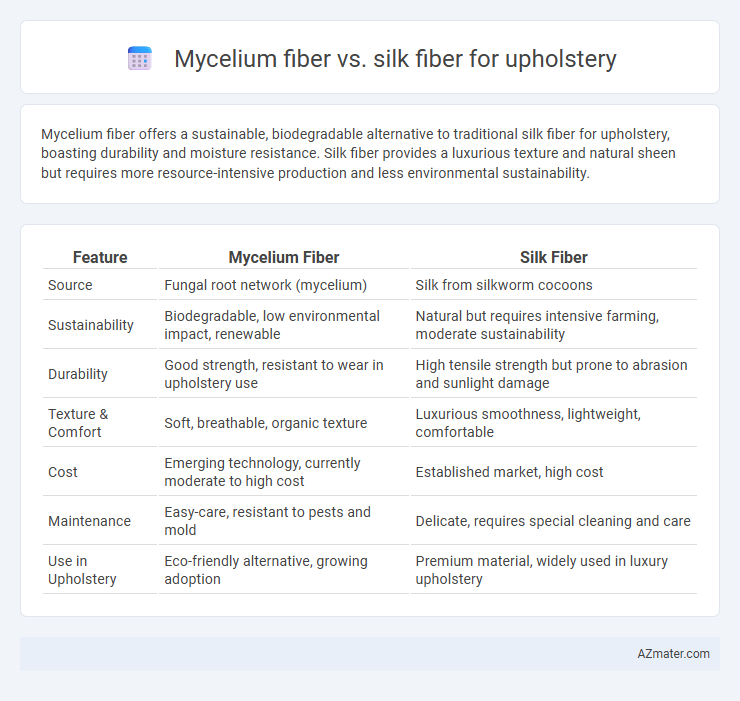Mycelium fiber offers a sustainable, biodegradable alternative to traditional silk fiber for upholstery, boasting durability and moisture resistance. Silk fiber provides a luxurious texture and natural sheen but requires more resource-intensive production and less environmental sustainability.
Table of Comparison
| Feature | Mycelium Fiber | Silk Fiber |
|---|---|---|
| Source | Fungal root network (mycelium) | Silk from silkworm cocoons |
| Sustainability | Biodegradable, low environmental impact, renewable | Natural but requires intensive farming, moderate sustainability |
| Durability | Good strength, resistant to wear in upholstery use | High tensile strength but prone to abrasion and sunlight damage |
| Texture & Comfort | Soft, breathable, organic texture | Luxurious smoothness, lightweight, comfortable |
| Cost | Emerging technology, currently moderate to high cost | Established market, high cost |
| Maintenance | Easy-care, resistant to pests and mold | Delicate, requires special cleaning and care |
| Use in Upholstery | Eco-friendly alternative, growing adoption | Premium material, widely used in luxury upholstery |
Introduction to Mycelium and Silk Fibers
Mycelium fiber, derived from the root structure of mushrooms, offers a sustainable and biodegradable alternative to traditional upholstery materials, providing natural breathability and durability. Silk fiber, produced by silkworms, is prized for its luxurious texture, strength, and resistance to wrinkles, making it a premium choice in upholstery. Both fibers present unique eco-friendly and functional qualities that influence their suitability in furniture design.
Origin and Production Methods
Mycelium fiber, derived from the root structure of fungi, is cultivated through a sustainable process involving the growth of fungal hyphae on agricultural waste, offering a biodegradable alternative for upholstery. Silk fiber originates from the cocoons of the Bombyx mori silkworm, produced through a labor-intensive harvesting and reeling process that yields a natural protein fiber known for its luster and strength. Both fibers differ significantly: mycelium fiber emphasizes eco-friendly, low-impact production, while silk fiber relies on traditional sericulture techniques with a longer production cycle.
Environmental Impact Comparison
Mycelium fiber offers a sustainable alternative to silk fiber for upholstery, as it is derived from fungal roots that grow rapidly with minimal water and no pesticides, significantly reducing environmental footprint. Silk production involves intensive mulberry cultivation and silkworm farming, which require substantial water, land, and chemical inputs, contributing to ecological strain and biodiversity loss. Mycelium's biodegradability and low-energy processing enhance its eco-friendly profile compared to silk, which demands energy-intensive harvesting and processing methods.
Texture and Aesthetic Differences
Mycelium fiber offers a unique, matte texture with a natural, organic appearance that enhances eco-friendly upholstery designs, contrasting with silk fiber's smooth, lustrous surface known for its luxurious sheen and elegant drape. The tactile quality of mycelium fiber provides a slightly coarse feel, suitable for rustic or modern interiors, while silk fiber delivers a soft, silky touch favored in high-end, classic upholstery. Aesthetically, mycelium fiber reflects earthy tones and uneven patterns, whereas silk showcases vibrant colors and refined finishes that elevate sophisticated decor.
Durability and Strength Analysis
Mycelium fiber demonstrates superior tensile strength and resistance to abrasion compared to traditional silk fiber, making it a highly durable choice for upholstery applications. Its natural robustness and ability to maintain structural integrity under stress contribute to longer-lasting furniture coverings. Silk fiber, while luxurious and soft, is more prone to wear and tear, requiring careful maintenance to preserve its strength and appearance.
Comfort and Sensory Qualities
Mycelium fiber offers a unique upholstery experience with its natural breathability and soft, lightweight texture, promoting enhanced comfort and moisture regulation. Silk fiber excels in its luxurious smoothness and exceptional sheen, providing a sensory-rich, silky touch that also naturally resists dust mites and allergens. Both fibers deliver distinctive tactile qualities, with mycelium emphasizing eco-friendly softness and silk highlighting elegance and refined comfort.
Maintenance and Care Requirements
Mycelium fiber upholstery offers superior resistance to stains and moisture, requiring minimal maintenance compared to silk fiber, which demands delicate handling and frequent dry cleaning to preserve its luster and texture. Mycelium's natural durability reduces wear and tear, making it ideal for high-traffic areas, whereas silk fibers are prone to fading and damage from sunlight and spills. Routine vacuuming and spot cleaning suffice for mycelium, while silk necessitates specialized care to prevent degradation and prolong its lifespan.
Cost and Accessibility
Mycelium fiber offers a cost-effective alternative to traditional silk fiber for upholstery, with production costs typically 30-50% lower due to its rapid growth and low resource requirements. While silk fiber remains less accessible because of labor-intensive harvesting and limited geographic production regions, mycelium fiber benefits from scalable cultivation in varied environments, enhancing its availability. This increased accessibility and reduced expense make mycelium fiber an attractive option for sustainable upholstery markets.
Applications in Modern Upholstery
Mycelium fiber offers a sustainable and eco-friendly alternative to traditional silk fiber in modern upholstery, providing excellent durability and biodegradability for furniture coverings. Unlike silk fiber, which is prized for its natural luster and softness, mycelium fiber enables innovative design applications by mimicking leather textures while maintaining a lower environmental footprint. These properties make mycelium fiber especially suitable for eco-conscious brands aiming to blend aesthetics with sustainability in contemporary upholstery projects.
Future Prospects and Innovations
Mycelium fiber offers a sustainable and biodegradable alternative to traditional silk fiber, with rapid growth potential and low environmental impact, making it ideal for future upholstery innovations. Advances in mycelium cultivation and processing technologies enable customization of texture and durability, positioning it as a competitive fabric against silk in luxury and eco-friendly markets. Emerging research focuses on enhancing mycelium's natural antimicrobial properties and blending with silk fibers to create hybrid upholstery materials that combine strength, softness, and sustainability.

Infographic: Mycelium fiber vs Silk fiber for Upholstery
 azmater.com
azmater.com